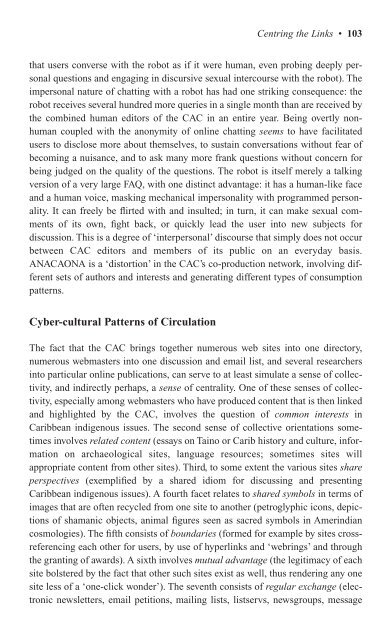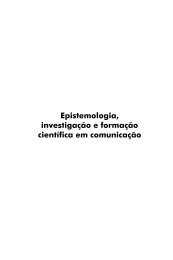Virtual Methods
Virtual Methods
Virtual Methods
Create successful ePaper yourself
Turn your PDF publications into a flip-book with our unique Google optimized e-Paper software.
that users converse with the robot as if it were human, even probing deeply personal<br />
questions and engaging in discursive sexual intercourse with the robot). The<br />
impersonal nature of chatting with a robot has had one striking consequence: the<br />
robot receives several hundred more queries in a single month than are received by<br />
the combined human editors of the CAC in an entire year. Being overtly nonhuman<br />
coupled with the anonymity of online chatting seems to have facilitated<br />
users to disclose more about themselves, to sustain conversations without fear of<br />
becoming a nuisance, and to ask many more frank questions without concern for<br />
being judged on the quality of the questions. The robot is itself merely a talking<br />
version of a very large FAQ, with one distinct advantage: it has a human-like face<br />
and a human voice, masking mechanical impersonality with programmed personality.<br />
It can freely be flirted with and insulted; in turn, it can make sexual comments<br />
of its own, fight back, or quickly lead the user into new subjects for<br />
discussion. This is a degree of ‘interpersonal’ discourse that simply does not occur<br />
between CAC editors and members of its public on an everyday basis.<br />
ANACAONA is a ‘distortion’ in the CAC’s co-production network, involving different<br />
sets of authors and interests and generating different types of consumption<br />
patterns.<br />
Cyber-cultural Patterns of Circulation<br />
Centring the Links • 103<br />
The fact that the CAC brings together numerous web sites into one directory,<br />
numerous webmasters into one discussion and email list, and several researchers<br />
into particular online publications, can serve to at least simulate a sense of collectivity,<br />
and indirectly perhaps, a sense of centrality. One of these senses of collectivity,<br />
especially among webmasters who have produced content that is then linked<br />
and highlighted by the CAC, involves the question of common interests in<br />
Caribbean indigenous issues. The second sense of collective orientations sometimes<br />
involves related content (essays on Taino or Carib history and culture, information<br />
on archaeological sites, language resources; sometimes sites will<br />
appropriate content from other sites). Third, to some extent the various sites share<br />
perspectives (exemplified by a shared idiom for discussing and presenting<br />
Caribbean indigenous issues). A fourth facet relates to shared symbols in terms of<br />
images that are often recycled from one site to another (petroglyphic icons, depictions<br />
of shamanic objects, animal figures seen as sacred symbols in Amerindian<br />
cosmologies). The fifth consists of boundaries (formed for example by sites crossreferencing<br />
each other for users, by use of hyperlinks and ‘webrings’ and through<br />
the granting of awards). A sixth involves mutual advantage (the legitimacy of each<br />
site bolstered by the fact that other such sites exist as well, thus rendering any one<br />
site less of a ‘one-click wonder’). The seventh consists of regular exchange (electronic<br />
newsletters, email petitions, mailing lists, listservs, newsgroups, message



